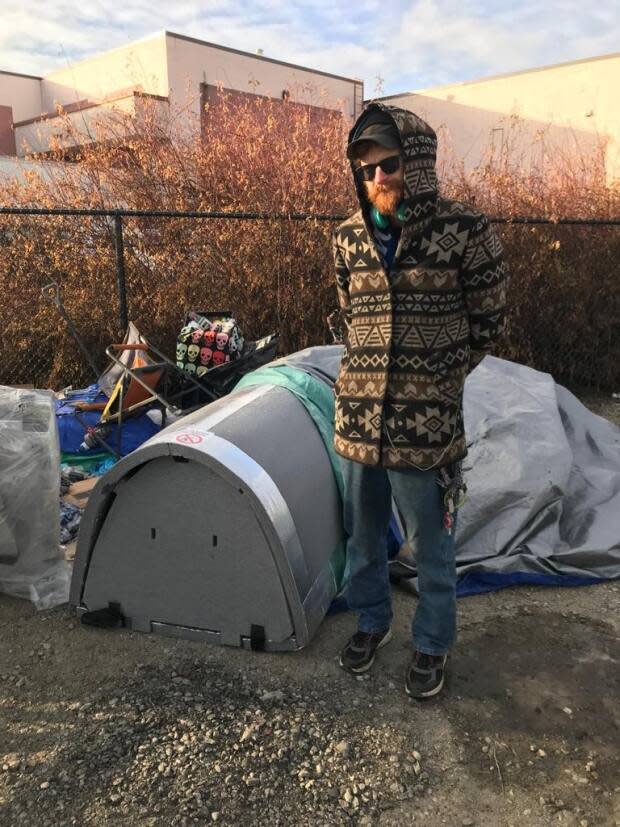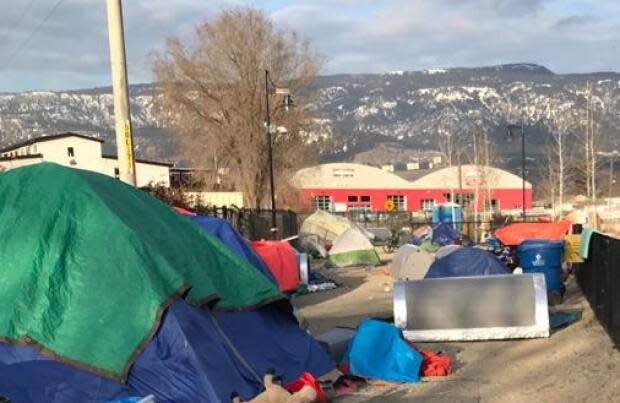Kelowna tests insulated shelters for its unhoused community

People experiencing homelessness in Kelowna, B.C., have a new option for keeping warm when temperatures drop below freezing.
As part of a pilot project, the City of Kelowna acquired 27 cold weather shelters from a European manufacturer. Each shelter is made from three pieces of lined and insulated foam and, according to the city, is fire-resistant.
Twenty of the tube-shaped shelters are designed for one person to lie down in. Seven are made for two.
The concept is to keep people wintering in tents better protected from the elements at a time of year when people who are unhoused are particularly vulnerable.
The shelters were distributed on a first-come, first-served basis for the first time on Jan. 27, in advance of a weekend cold snap that saw temperatures drop as low as –11 C.
Ryan Romaniuk, one of about a dozen people who used the shelter, gave it a mixed review.
"It comes apart at the seams. It lets wind in," he told CBC Daybreak South's Alya Ramadan. "[But] it definitely helps.
"I just put it into my other tent because it opens at either end, the igloo. And so I can put my blankets in there. It was OK. In the morning, your feet start to get cold."

Romaniuk says a bylaw services officer set the shelter up for him. He says the structure is "no better than a tent" but "great" for people who have nothing.
According to the city, body heat alone can raise the air temperature inside an insulated shelter as much as 18 C compared to the temperature outside.
Shelters must be returned after use
As per City of Kelowna regulations, the shelters must be set up at a designated outdoor sheltering site at the north end of downtown. People using them must also agree to return them when conditions warm up so they can be prepared for redistribution ahead of the next cold weather event.
Currently, an estimated 100 people are sleeping outside on the streets of Kelowna on any given night, as all indoor shelters in the city are full.
Across B.C., death rates among unhoused people have increased sharply over the past decade — from 31 in 2012 to 247 in 2021, according to the B.C. Coroners Service.

'The jury is out right now'
In Kelowna, the 27 insulated shelters were purchased with money from B.C. Housing. The city says they are currently the only ones of their kind in Canada.
Kevin Mead, the bylaw services manager with the City of Kelowna, says feedback from people using the shelters is an important part of the pilot project. As for Romaniuk's observation about gaps in the physical design, Mead says they are an intentional safety feature.
"That's really a mitigation measure in case, for whatever reason, fire or whatnot breaks out inside of the tent, and then it can be evacuated," he told CBC's Daybreak South.
In terms of evaluating the success of the pilot project, Mead says the biggest factor will be whether or not it's serving the needs of the community as intended.
"The jury is out right now," he said. "Ryan's feedback is a really great testament, and it is a sentiment that we've heard from other community members out there as well — that it is as good, if not better, than a tent and does provide some relief."

